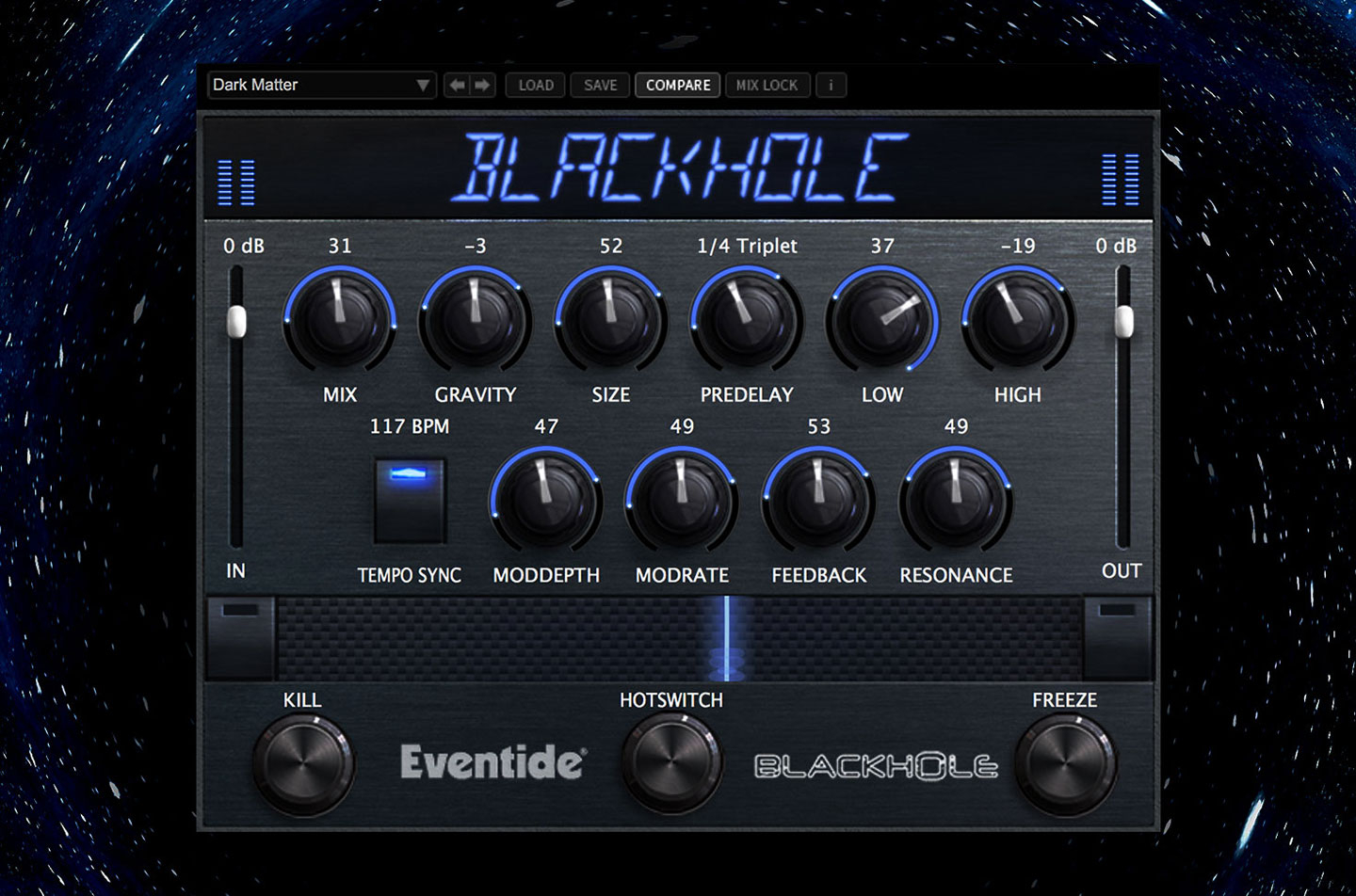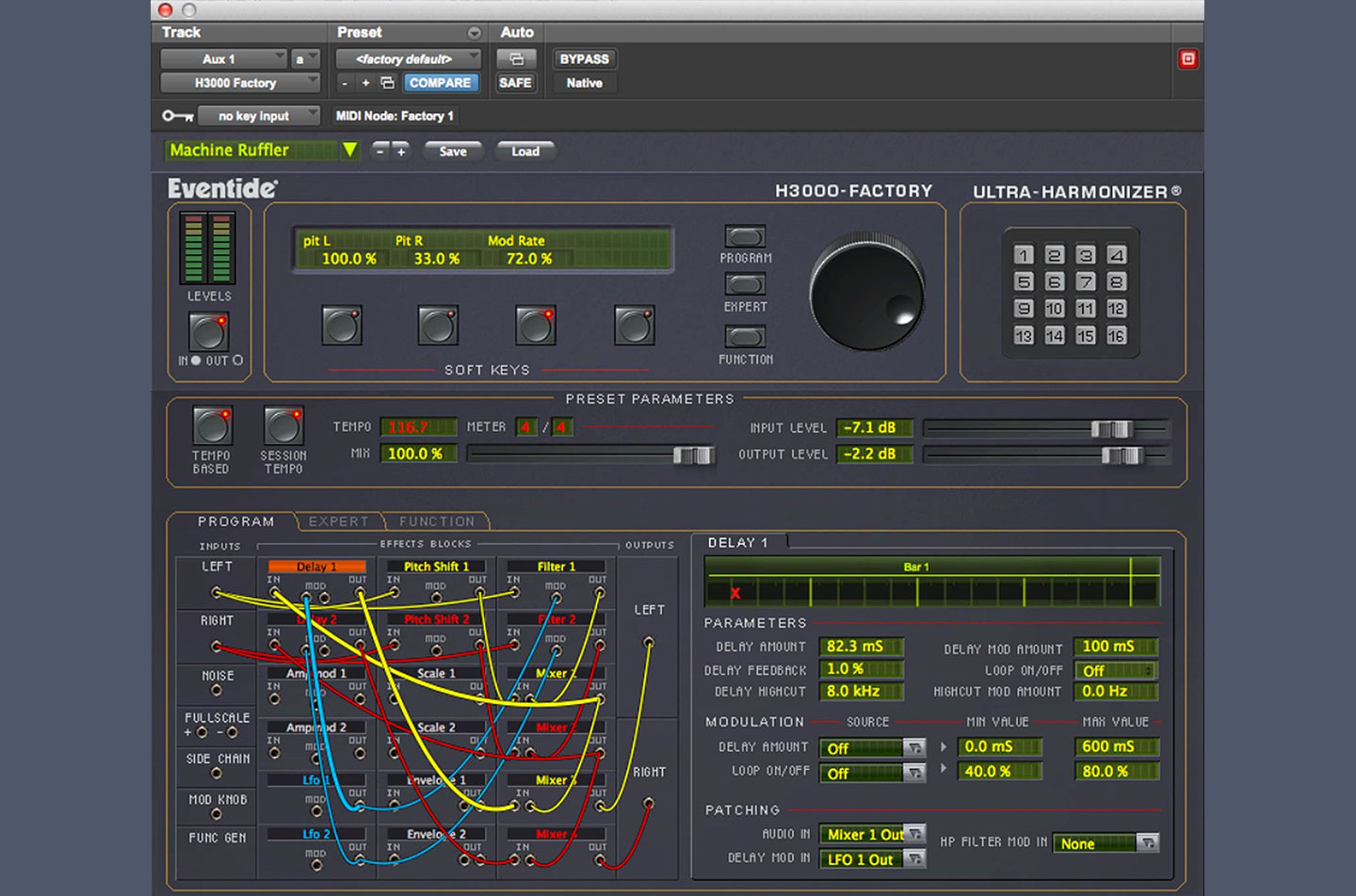- In the world of hardware effect processors, few names can match Eventide's acclaim. Going back all the way to the '70s, their Instant Phaser and H910 Harmonizer generated groundbreaking sounds on albums like David Bowie's Low. They also covered utilitarian applications like correcting the pitch of TV shows that had been sped up to allow more time for commercials. Many of their most well-received effects were developed back in the days when RAM had just been invented, so it's no exaggeration to say that Eventide was a pioneer in digital audio effects. The innovation continues today with high-end units like the mammoth H8000FW rack effects processor, which remains one of the most lust-worthy hardware units on the market 12 years after it was first introduced.
When it comes to software, Eventide first embraced the Pro Tools TDM format. Back in 2003, they released Clockworks Legacy, their first ever TDM plug-in bundle, which included the H910 and H949 Harmonizers, a sophisticated compressor called Omnipresso and the classic Instant Phaser and Instant Flanger units. Over the next three years they continued to add new TDM plug-ins to the suite, rebranding it as the more impressive-sounding Anthology bundle. As the computing world evolved, the desire for TDM plug-ins waned, and in late 2015 they made the jump to the native VST / AU format with Anthology X. This included many algorithms from classic Eventide hardware units like the H8000 and H3000, which were cleverly repackaged into 17 different plug-ins. With a high asking price and a heavier focus on mixing and tracking use cases, many electronic producers passed on the bundle in favour of alternatives from SoundToys or Waves. However, this December Eventide released its latest bundle, Anthology XI, which includes new effects that make it more attractive to producers working in less traditional realms.
A good example of the new creative plug-ins added to Anthology XI is Fission, the first of Eventide's Structural Effects range. This is a new core technology developed by Eventide that lets you split incoming audio into separate transient and tonal parts in real-time for independent processing. We reviewed this plug-in back in March, and were impressed with the myriad ways it could be used. It's great for tuning drums and percussion, since you can independently adjust the tonal portion of a drum hit while leaving the crucial transient intact from a pitch and energy perspective. You can also use it for extreme sound design, like removing all transients from a sample or enhancing them with delay or reverb. Fission includes six transient effects and seven tonal effects, and the ability to tweak the split engine in many ways. It's surprising how much it can do.
Reverbs are also well represented in Anthology XI's new additions. The two that I was most excited about were Blackhole and MangledVerb. These plug-ins are essentially recreations of two of the best algorithms from Eventide's Space stompbox, and they have a look and feel that matches the hardware. This greatly improves usability compared to the older Eventide UIs, which tended to feel a bit complex. Blackhole, MangledVerb and UltraTap all have well-designed controls over the most important parameters of their respective algorithms. But most exciting are the ribbon and hotswitch controls, which allow you to morph and swap between two snapshots of the effect's parameters. These are definitely the non-traditional reverbs of the bunch, with Blackhole specialising in huge ambient soundscapes and MangledVerb incorporating a complex distortion algorithm into its reverb chain for additional grit. If you're looking for more realistic reverbs, Anthology XI's 2016 Stereo Room and UltraReverb can fit the bill.
The H3000 Factory in particular gave me countless "wow" moments during my time testing the plug-in. While it's getting on in age (having first made an appearance in the original Anthology TDM collection in 2006), the sheer power housed within the modular environment of the plug-in is astounding. Also, there's another benefit to the slightly older codebase that the H3000 Factory and other original Eventide effects are built on: CPU efficiency. If it was designed to run on computers over a decade ago and sound great doing so, today's modern processors would have no problem stacking multiple instances within a single session.
Other highlights from the older plug-ins include the H910/H949 Harmonizers, which sparkle with the characteristic sound of '80s music production, and the Octavox/Quadrovox pitch shifters. Octavox in particular is a bit of a hidden gem. The ability to use a piano-roll sequencer to draw in the pitch and timing of its eight pitch-shifters yields the most musical approach to this style of effect that I've seen before.
When it comes down to it, the main downside with Anthology XI is the asking price. If you own other Eventide plug-ins or bundles, the upgrade costs can be significantly reduced. But if you're coming in fresh to the world of Eventide, the asking price is pretty steep: $1799. When you compare this to something like SoundToys 5, which retails at $499, it can seem a bit overwhelming. However, if purchased individually, the plug-ins included in Anthology XI would cost over $3500. Even if you just wanted Blackhole, Fission and H3000 Factory, you'd be close to the price of Anthology purchasing those on their own. But if you've got the money and are looking for a CPU-friendly effect suite that covers a huge spectrum of audio processing, Anthology XI is worth your consideration.
Ratings:
Cost: 3.7
Versatility: 4.6
Ease of use: 4.0
Sound: 4.9
 Reverbs are also well represented in Anthology XI's new additions. The two that I was most excited about were Blackhole and MangledVerb. These plug-ins are essentially recreations of two of the best algorithms from Eventide's Space stompbox, and they have a look and feel that matches the hardware. This greatly improves usability compared to the older Eventide UIs, which tended to feel a bit complex. Blackhole, MangledVerb and UltraTap all have well-designed controls over the most important parameters of their respective algorithms. But most exciting are the ribbon and hotswitch controls, which allow you to morph and swap between two snapshots of the effect's parameters. These are definitely the non-traditional reverbs of the bunch, with Blackhole specialising in huge ambient soundscapes and MangledVerb incorporating a complex distortion algorithm into its reverb chain for additional grit. If you're looking for more realistic reverbs, Anthology XI's 2016 Stereo Room and UltraReverb can fit the bill.
Reverbs are also well represented in Anthology XI's new additions. The two that I was most excited about were Blackhole and MangledVerb. These plug-ins are essentially recreations of two of the best algorithms from Eventide's Space stompbox, and they have a look and feel that matches the hardware. This greatly improves usability compared to the older Eventide UIs, which tended to feel a bit complex. Blackhole, MangledVerb and UltraTap all have well-designed controls over the most important parameters of their respective algorithms. But most exciting are the ribbon and hotswitch controls, which allow you to morph and swap between two snapshots of the effect's parameters. These are definitely the non-traditional reverbs of the bunch, with Blackhole specialising in huge ambient soundscapes and MangledVerb incorporating a complex distortion algorithm into its reverb chain for additional grit. If you're looking for more realistic reverbs, Anthology XI's 2016 Stereo Room and UltraReverb can fit the bill. The H3000 Factory in particular gave me countless "wow" moments during my time testing the plug-in. While it's getting on in age (having first made an appearance in the original Anthology TDM collection in 2006), the sheer power housed within the modular environment of the plug-in is astounding. Also, there's another benefit to the slightly older codebase that the H3000 Factory and other original Eventide effects are built on: CPU efficiency. If it was designed to run on computers over a decade ago and sound great doing so, today's modern processors would have no problem stacking multiple instances within a single session. Other highlights from the older plug-ins include the H910/H949 Harmonizers, which sparkle with the characteristic sound of '80s music production, and the Octavox/Quadrovox pitch shifters. Octavox in particular is a bit of a hidden gem. The ability to use a piano-roll sequencer to draw in the pitch and timing of its eight pitch-shifters yields the most musical approach to this style of effect that I've seen before. When it comes down to it, the main downside with Anthology XI is the asking price. If you own other Eventide plug-ins or bundles, the upgrade costs can be significantly reduced. But if you're coming in fresh to the world of Eventide, the asking price is pretty steep: $1799. When you compare this to something like SoundToys 5, which retails at $499, it can seem a bit overwhelming. However, if purchased individually, the plug-ins included in Anthology XI would cost over $3500. Even if you just wanted Blackhole, Fission and H3000 Factory, you'd be close to the price of Anthology purchasing those on their own. But if you've got the money and are looking for a CPU-friendly effect suite that covers a huge spectrum of audio processing, Anthology XI is worth your consideration. Ratings: Cost: 3.7 Versatility: 4.6 Ease of use: 4.0 Sound: 4.9
The H3000 Factory in particular gave me countless "wow" moments during my time testing the plug-in. While it's getting on in age (having first made an appearance in the original Anthology TDM collection in 2006), the sheer power housed within the modular environment of the plug-in is astounding. Also, there's another benefit to the slightly older codebase that the H3000 Factory and other original Eventide effects are built on: CPU efficiency. If it was designed to run on computers over a decade ago and sound great doing so, today's modern processors would have no problem stacking multiple instances within a single session. Other highlights from the older plug-ins include the H910/H949 Harmonizers, which sparkle with the characteristic sound of '80s music production, and the Octavox/Quadrovox pitch shifters. Octavox in particular is a bit of a hidden gem. The ability to use a piano-roll sequencer to draw in the pitch and timing of its eight pitch-shifters yields the most musical approach to this style of effect that I've seen before. When it comes down to it, the main downside with Anthology XI is the asking price. If you own other Eventide plug-ins or bundles, the upgrade costs can be significantly reduced. But if you're coming in fresh to the world of Eventide, the asking price is pretty steep: $1799. When you compare this to something like SoundToys 5, which retails at $499, it can seem a bit overwhelming. However, if purchased individually, the plug-ins included in Anthology XI would cost over $3500. Even if you just wanted Blackhole, Fission and H3000 Factory, you'd be close to the price of Anthology purchasing those on their own. But if you've got the money and are looking for a CPU-friendly effect suite that covers a huge spectrum of audio processing, Anthology XI is worth your consideration. Ratings: Cost: 3.7 Versatility: 4.6 Ease of use: 4.0 Sound: 4.9